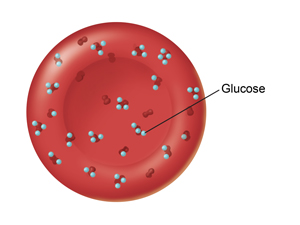Managing Diabetes: The A1C Test
Managing Diabetes: The A1C Test
|
|
Healthy red blood cells have some glucose stuck to them. |
A high A1C means that unhealthy amounts of glucose are stuck to the cells. |
What is the A1C test?
Using your meter helps you track your blood sugar every day. But your glucose meter tells you the value at the time of testing only. You also need to know if your treatment plan is keeping you healthy over time. The hemoglobin A1C (or glycated hemoglobin) test can help. This test measures your average blood sugar level over a few months. A higher A1C result means that you have a higher risk of developing complications.
The A1C test
The A1C is a blood test done by your healthcare provider. You will likely have an A1C test every 3 to 6 months.
Your blood glucose goal
A1C has been shown as a percentage. But it can also be shown as a number representing the estimated Average Glucose (eAG). Unlike the A1C percentage, eAG is a number similar to the numbers listed on your daily glucose monitor. Both A1C and eAG measure the amount of glucose stuck to a protein called hemoglobin in red blood cells. Your healthcare provider will help you figure out what your ideal A1C or eAG should be. Your target number will depend on your age, general health, and other factors. If your current number is too high, your treatment plan may need changes, such as different medicines.
Sample results
Most people aim for an A1c lower than 7%. That’s an eAG less than 154 mg/dL. Or, your healthcare provider may want you to aim for an A1C of 6%. That’s an eAG of 126 mg/dL.
Glucose calculator
Visit http://professional.diabetes.org/diapro/glucose_calc for a chart that helps convert your A1C percentages into eAG numbers.
Updated:
October 13, 2017
Reviewed By:
Hurd, Robert, MD,Image reviewed by StayWell medical illustration team.,Sather, Rita, RN

